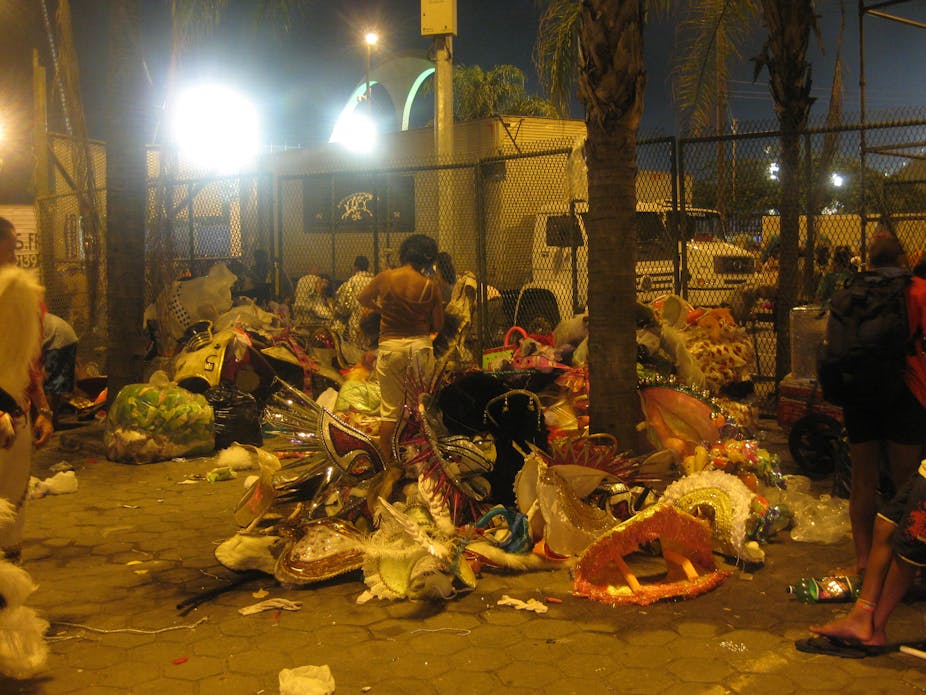A television on the wall of a Swanston Street café plays footage from Rio de Janeiro’s famous Carnaval. Across the screen swan spectacular drum queens and passistas, their muscular bodies gleaming with sweat, adorned with jewels and plumage.
In the imagination of global audiences, such images have come to represent the quintessential Brazil.
Yet carnaval is arguably the one week of the Brazilian year that least represents life in Brazil. With its roots in European pre-Lent celebrations – and a 400 year history of creolisation into a uniquely Brazilian phenomenon – carnaval is in fact seen as a reversal of every day life in Brazil.
A social release and a momentary abandonment of all the usual conventions, hierarchies and pressures, it is the one week when everybody has permission to be anybody or anything, with the help of wild disguises and costumes (“fantasias”).
Perception meets reality
Carnaval is also the one time of year when Brazil is guaranteed a news slot on televisions across the globe, and the ironic effect is that images of the moment when “normal” life is abandoned have come to be interpreted as a reflection of what life must be like in Brazil and what all Brazilians must be like: flamboyant, unwaveringly joyful and scantily clad.
This incongruity between global and local perceptions of Brazil was clearly highlighted by the worldwide coverage of a 20-year-old student’s expulsion from a São Paulo university in 2009 for wearing a short skirt. The student’s mini skirt incited the violent ridicule of her classmates, and the Universidade Bandeirante (Uniban) that expelled her cited “flagrant disrespect of ethical principles, academic dignity and morality.”
The case was not so surprising within the conservative Catholic context of São Paulo, but that subtlety was lost on foreign news desks, with reports contrasting the university’s action against Brazil’s fame for “tiny bikinis and carefree attitude”.
In a global spotlight
The story also highlighted another emerging reality for Brazil – the growing influence of external scrutiny in a globalised world. Amid the international media flurry, the university took less than 24 hours to reverse its decision and reinstate the student, showing how global perceptions (even if naive or culturally uninformed) can provoke very real transformations at the local level, and sometimes very quickly.
During the last carnaval in Rio de Janeiro, I found myself seated at the far end of the sambadrome stadium at its final stretch where the performers spill out onto the street. What would usually be considered the worst spot in the stadium turned out to be offer the best view of a place where two realities of Brazil collide. In the dark street behind the luminous sambadrome stage, workmen in orange suits soared into the air with cranes to rescue feathered dancers from the tops of the extravagant floats.

On the street below, exhausted paraders milled around stripping off their regalia and throwing it onto growing mountains of discarded costumes, raggedly dressed foragers rummaged through the piles to retrieve resaleable feathers and fabrics while city garbage collectors loaded piles of costume debris into trucks. I could not help marveling at the richness and metaphoric significance of this backstage scene that audiences of the televised carnaval might never see.
What you don’t see
Watching the televised spectacle from a faraway lounge room, who could know that the dazzling passista girl dancing across the screen goes home at night to a tiny delapidated room with a dirt floor in a favela (shantytown) where a drug war rages outside her door? Like a modern-day Cinderella, when the night is over she disappears again into anonymity; into the invisibility, marginality and insignificance of her quotidian life.
Who could know that a few steps in any direction from this gleaming sambadrome sprawl dark and sometimes dangerous streets, where crowds of spectators and half-costumed dancers tread cautiously through pools of dirt and urine and debris?
Many of the sambadrome show’s stars crowd into buses that carry them home to favelas, while visiting tourists hail taxis that whisk them in the opposite direction to the airconditioned safety of their hotels at Ipanema or Copacabana beach. And beyond the sambadrome those two worlds rarely meet, thus reproducing the same global stereotypes even in the minds of many who travel to Rio.
Who tells Brazil’s story?
Adding to this, it is not unusual for local Brazilians, with whom tourists might typically mix in these wealthier zones, to have never set foot in a favela in their lifetimes.
Over the next five years, more of the world’s eyes than ever will turn to Brazil, the economic superstar of the moment and the next host of both the Fifa World Cup and Olympic Games. International visitors will pour into Brazil from every direction. What is certain is that these “outside observers”, whether visiting the country physically or virtually, are not passive observers as is often imagined.
Through the very act of turning their eyes in Brazil’s direction they become participants in her future. For Brazil, an intensified dialogue with the global audience over the coming years is inevitable; how this translates into the lives of ordinary Brazilians is a story yet to unfold, and one that will be written by each person who takes part in this dialogue.

